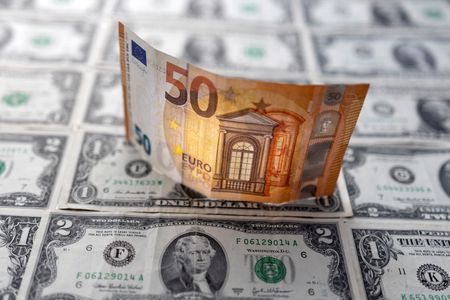

By Sinéad Carew
(Reuters) – The euro sank on Tuesday to its weakest level against the dollar in almost 20 years while oil futures tumbled and bond prices rose as investors sought safety after the latest data heightened fears of a global economic slowdown.
Recession fears were exacerbated by concerns about an energy crisis and by Tuesday’s data, which showed a sharp slowdown in business growth in June, following Monday’s news of a seasonally adjusted May trade deficit in Germany versus expectations for a surplus.
Oil prices plunged as concerns that a global recession would curtail demand appeared to outweigh supply disruption fears related to an expected production cut in Norway. [O/R]
U.S. equities pared some losses as the session wore on after falling sharply early in the session, following their closure for Monday’s holiday.
Bipan Rai, North America head of FX strategy at CIBC Capital Markets in Toronto, pointed to signs of a looming energy crisis in Europe and mounting economic concerns for the euro’s tumble.
“The threat of a recession in the euro zone is a more clear risk now relative to before,” Rai said.
The euro dropped by almost 1.8% against the dollar to $1.0236, its weakest since December 2002. It was last down 1.5% against the dollar.
Meanwhile the dollar index, which measures the greenback against a group of major currencies, was up 1.36%, after hitting its highest level since December 2002. The dollar is seen as a safe haven in times of acute economic uncertainty.
“The demand for the safety of dollar-based assets is up as expectations for economic activity are significantly lower,” said Shawn Cruz, head trading strategist at TD Ameritrade in Chicago. He noted that Germany’s news was causing a “major reassessment” among investors.
“If people are concerned there’s going to be a slowdown and put their money in the safest place and cut back on unnecessary spending, it can become a self-fulfilling prophesy.”
The Japanese yen strengthened 0.01% versus the greenback at 135.69 per dollar, while sterling was last trading at $1.1943, down 1.34% on the day.
(Graphic: Euro vs dollar: https://fingfx.thomsonreuters.com/gfx/mkt/egvbkgdompq/euro%202002.PNG)
The Dow Jones Industrial Average fell 325.28 points, or 1.05%, to 30,771.98, the S&P 500 lost 17.02 points, or 0.44%, to 3,808.31 while the Nasdaq Composite added 121.94 points, or 1.1%, to 11,249.78.
The pan-European STOXX 600 index lost 2.11% and MSCI’s gauge of stocks across the globe shed 0.87% but was still managing to stay above its June 17 trough, which had been its lowest level since November 2020.
Benchmark U.S. Treasury yields tumbled and a key part of the yield curve inverted for the first time in three weeks as concerns about economic growth dented risk appetite and increased demand for safe haven U.S. debt.
U.S. 10-year notes last rose 26/32 in price to yield 2.809%, from 2.904% late on Friday. The 2-year note last rose 2/32 in price to yield 2.8163%, from 2.845%.
Investors are watching out this week for the U.S. Federal Reserve and European Central Bank minutes from their most recent policy meetings, as well as U.S. payroll numbers for June due on Friday.
News that Norwegian offshore workers began a strike on Tuesday that will reduce oil and gas output has compounded fears about a European energy shortage.
U.S. crude settled down 8.24% at $99.50 per barrel and Brent settled at $102.77, down 9.45% on the day.
Spot gold dropped 2.3% to $1,767.05 an ounce.
Bitcoin was virtually unchanged from the previous session at $20211.63.
(Additional reporting by Herbert Lash in New Yor, Thomas Wilkes, Dhara Ranasinghe and Sujata Rao in London and Kane Wu and Alun John in Hong Kong; Editing by Chizu Nomiyama, Alex Richardson and Mark Heinrich)

